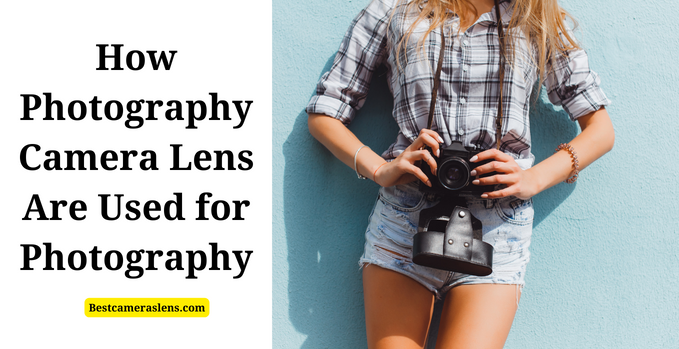Photography is an art form that allows us to capture moments and create lasting memories. Behind every stunning photograph lies a skilled photographer who understands the importance of using the right camera lens.
In this blog post, we will explore the fascinating world of photography camera lenses and how they are used to elevate your photographic experience.
Understanding Different Types of Camera Lenses
Before we delve into their usage, let’s familiarize ourselves with different types of camera lenses. Each lens serves a specific purpose and offers unique features that can significantly impact your photographs:
- Prime Lenses: Prime lenses have a fixed focal length, meaning they do not zoom in or out. These lenses are known for their exceptional image quality, wider maximum apertures, and lightweight design.
- Zoom Lenses: Unlike prime lenses, zoom lenses offer variable focal lengths, allowing you to adjust the magnification level as desired. They provide versatility by covering a range of focal lengths within a single lens.
- Wide-angle Lenses: Wide-angle lenses have shorter focal lengths, typically ranging from 14mm to 35mm. These lenses capture a wider field of view, making them ideal for landscape photography or situations where you want to emphasize perspective.
- Telephoto Lenses: Telephoto lenses excel at capturing distant subjects with great detail and clarity. With longer focal lengths (often starting at 70mm), these lenses are perfect for wildlife photography, sports events, or any scenario where you need to bring distant subjects closer.
- Macro Lenses: Macro lenses are designed specifically for close-up photography. They allow you to capture intricate details with high magnification ratios, making them popular among nature photographers and enthusiasts who enjoy macro photography.
Now that we have an understanding of the different types of camera lenses let’s explore how each one can be effectively used in various photographic scenarios.
Capturing Breathtaking Landscapes with Wide-angle Lenses
Wide-angle lenses are a landscape photographer’s best friend. These lenses allow you to capture expansive vistas, majestic mountains, and stunning sunsets in all their glory. With their wider field of view, wide-angle lenses enable you to create dramatic compositions by emphasizing the foreground and adding depth to your shots.
When using a wide-angle lens, try incorporating leading lines into your composition to draw the viewer’s eye into the scene. Experiment with different angles and perspectives to capture unique viewpoints that showcase the grandeur of nature. Remember to pay attention to the foreground and background elements as well, as they can add interesting layers to your photographs.
Zoom Lenses: Versatility at Your Fingertips
Zoom lenses are a fantastic tool for photographers who value flexibility and convenience. By offering a range of focal lengths within a single lens, zoom lenses allow you to quickly adapt to different situations without needing to switch lenses constantly.
One popular application of zoom lenses is in portrait photography. With their ability to zoom in and out, these lenses enable you to frame your subject precisely while maintaining an appropriate distance. Zooming in helps you capture intimate details and expressions while zooming out allows you to include more of the surroundings for context.
Additionally, zoom lenses are highly useful for event photography where moments unfold rapidly. You can effortlessly switch between wide-angle shots that capture the overall atmosphere and telephoto shots that bring individual subjects closer without having to change your lens.
Exploring the World of Macro Photography
Macro photography opens up a whole new world filled with intricate details often overlooked by the naked eye. Macro lenses excel at capturing tiny subjects such as flowers, insects, or even droplets of water with incredible clarity and precision.
To make the most out of macro photography, it’s essential to have patience and a steady hand. Achieving sharp focus on such small subjects requires precision, so consider using a tripod and remote shutter release to minimize camera shake. Experiment with different lighting techniques, such as diffused natural light or artificial macro lighting setups, to enhance the details and textures of your subjects.
Macro photography allows you to appreciate the beauty of the smallest things in life and unveils a hidden world that often goes unnoticed.
Telephoto Lenses: Bringing Distant Subjects Closer
Telephoto lenses are known for their ability to capture distant subjects with stunning clarity. Whether you’re photographing wildlife in their natural habitats or capturing candid moments from afar, telephoto lenses allow you to get up close without disturbing your subject.
One important factor to consider when using telephoto lenses is image stabilization. Due to their longer focal lengths, any slight movement can result in blurred images. To combat this, many telephoto lenses come equipped with image stabilization technology that compensates for camera shake and delivers sharper images.
Telephoto lenses also excel in portrait photography by providing flattering compression and isolating your subject from the background. The shallow depth of field achieved with longer focal lengths creates a beautiful bokeh effect that adds depth and visual appeal to your photographs.
Conclusion: Unleashing Your Creative Vision with Camera Lenses
Camera lenses are powerful tools that enable photographers to tell stories, capture emotions, and freeze time. From wide-angle lenses that bring breathtaking landscapes to life, zoom lenses that offer versatility at your fingertips, macro lenses that reveal hidden worlds, to telephoto lenses that bring distant subjects closer—each lens has its unique capabilities.
As you embark on your photographic journey, remember that choosing the right lens for each scenario will allow you to unleash your creativity and capture extraordinary moments. Embrace experimentation, push boundaries, and let your camera lens be an extension of your vision as you navigate the world of photography.
